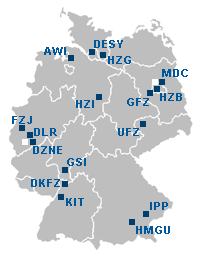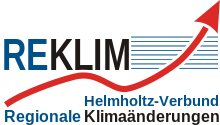Helmholtz Association of German Research Centres
| Helmholtz-Gemeinschaft Deutscher Forschungszentren e.V. | |
 | |
| Agency overview | |
|---|---|
| Formed | 2001 |
| Preceding agency |
|
| Headquarters | Bonn and Berlin |
| Employees | 37148 [1] |
| Annual budget | 3.95 billion Euro (2.69 core and 1.26 third-party funding) [1] |
| Agency executive | |
| Website | www.helmholtz.de |
The Helmholtz Association of German Research Centres (German: Helmholtz-Gemeinschaft Deutscher Forschungszentren) is the largest scientific organisation in Germany. It is a union of 18 scientific-technical and biological-medical research centers. The official mission of the Association is "solving the grand challenges of science, society and industry". Scientists at Helmholtz therefore focus research on complex systems which affect human life and the environment. The namesake of the association is the German physiologist and physicist Hermann von Helmholtz.[2]
The annual budget of the Helmholtz Association amounts to more than 3.4 billion euros, of which about 70% is raised from public funds. The remaining 30% of the budget is acquired by the 18 individual Helmholtz Centres in the form of contract funding. The public funds are provided by the federal government (90%) and the rest by the States of Germany (10%).[2]
Members

Members of the Helmholtz Association are:
- Alfred Wegener Institute for Polar and Marine Research (Alfred-Wegener-Institut für Polar- und Meeresforschung, AWI), Bremerhaven
- German Electron Synchrotron (Deutsches Elektronen-Synchrotron, DESY), Hamburg
- German Cancer Research Center (Deutsches Krebsforschungszentrum, DKFZ), Heidelberg
- German Aerospace Center (Deutsches Zentrum für Luft- und Raumfahrt, DLR), Cologne
- German Center for Neurodegenerative Diseases (Deutsches Zentrum für Neurodegenerative Erkrankungen; DZNE), Bonn
- Forschungszentrum Jülich (FZJ) Jülich Research Centre, Jülich
- Karlsruhe Institute of Technology (Karlsruher Institut für Technologie, KIT), (formerly Forschungszentrum Karlsruhe), Karlsruhe
- Helmholtz Centre for Infection Research, (Helmholtz-Zentrum für Infektionsforschung, HZI), Braunschweig
- Helmholtz Centre Potsdam GFZ German Research Centre for Geosciences (Helmholtz-Zentrum Potsdam – Deutsches GeoForschungsZentrum GFZ, Potsdam
- Helmholtz-Zentrum Geesthacht Centre for Materials and Coastal Research (HZG), Geesthacht, formerly known as Gesellschaft für Kernenergieverwertung in Schiffbau und Schiffahrt mbH (GKSS)
- Helmholtz Zentrum München German Research Centre for Environmental Health (HMGU), Neuherberg
- GSI Helmholtz Centre for Heavy Ion Research (GSI Helmholtzzentrum für Schwerionenforschung), Darmstadt
- Helmholtz-Zentrum Berlin for Materials and Energy (Helmholtz-Zentrum Berlin für Materialien und Energie, HZB), Berlin
- Helmholtz Centre for Environmental Research (Helmholtz-Zentrum für Umweltforschung, UFZ), Leipzig
- Max Planck Institute of Plasma Physics (Max-Planck-Institut für Plasmaphysik, IPP), Garching
- Max Delbrück Center for Molecular Medicine in the Helmholtz Association (Max-Delbrück-Centrum für Molekulare Medizin in der Helmholtz-Gemeinschaft, MDC), Berlin-Buch
- Helmholtz-Zentrum Dresden-Rossendorf (HZDR) formerly known as Forschungszentrum Dresden-Rossendorf (FZD) changed 2011 from the Leibniz Association to the Helmholtz Association of German Research Centres,[3] Dresden
- Helmholtz Centre for Ocean Research Kiel (GEOMAR) formerly known as Leibniz Institute of Marine Sciences (IFM-GEOMAR)
- Helmholtz Institute for RNA-based Infection Research (HIRI), Würzburg, which will be established in 2017[4]
Programme structure
The works of the centres are categorised into programmes, which are divided into six research groups.[5] The Helmholtz centres are grouped according to which research group they belong to:
- Energy includes contributions from DLR, KIT, FZJ, GFZ, HZB, HZDR, IPP. Topics are Renewable energies,energy efficient conversion, nuclear fusion and nuclear safety.
- Earth and environment is studied at AWI, DLR, FZJ, KIT, HZI, GFZ, HZG, HMGU, UFZ. Topics are the The changing earth, marine, coastal and polar systems, atmosphere and climate, biogeosystems and the topic terrestrial environment.
- Health is studied at the DKFZ, FZJ, KIT, HZI, DZNE HZG, HMGU, GSI, HZB, HZDR, MDC, and UFZ. This includes cancer research, cardio-vascular and metabolic disease research, (dys)function of the nervous system, infection and immunity, environmental health studies, comparative genomics for human health.
- Key Technologies are studied at FZJ, KIT, HZG. In a single topic there is cooperations of the HZB.
- Structure of Matter is studied at DESY, FZJ, KIT, HZG, GSI, HZB), HZDR. Topics are elementary and astroparticle physics, hadrons and nuclear physics, PNI-research (research with Photons, Neutrons and Ions), aeronautics, space and transport research.
- Aeronautics, Space and Transport is studied at DLR. Major research topics are mobility, information systems and communication.
The Helmholtz Climate Initiative

Eight of the above-mentioned Helmholtz centers are part of the Helmholtz Climate Initiative Regional Climate (in German: Regionale Klimainitiative) REKLIM in order to tackle the interactions between atmosphere, sea ice, ocean and land surfaces. These interactions determine the climate of the Earth. Detailed observations and process studies are combined within the initiative. For the funding period 2009-2013 the REKLIM-initiative has a budget of 32.2 million Euro.[6] In this funding period, the program is divided into seven topics, each of the topics is organized in various work-packages.
- Coupled modelling of regional earth systems. Model regions are the Arctic and Europe. Highly resolved regional model are used to simulate atmosphere, ocean, sea ice, ice sheets, land surface, soil, vegetation, aerosol chemistry and other components on a regional scale.
- Sea-level changes and coastal protection. The effects of glacier and ice-stream dynamics, the response of the ocean on heating and melt water run-off are studied in particularly for Greenland.
- Regional climate changes in the Arctic Forcing and long-term effects at the land-ocean interface
- The land surface in the climate system
- Chemistry-climate interactions on global to regional scales
- Extreme weather events Storms, heavy precipitation, floods and droughts
- Socio-economics and management Climate change adaptation and mitigation strategies
In the second funding period (2011-2015), three additional topics have been added.
References
Note: Forschungszentrum Karlsruhe is often abbreviated as FZK, although this violates the rights of Feuerverzinkerei FZK Karlsruhe.
- 1 2 Helmholtz Annual Report 2014
- 1 2 Helmholtz Association - About Us retrieved 24-May-2012.
- ↑ "Pressemitteilung vom 22. Juni 2009: Per Unterschrift besiegelt – das FZD wechselt zur Helmholtz-Gemeinschaft Deutscher Forschungszentren (german)". FZD. 2009-05-22. Retrieved 2009-05-22.
- ↑ Press release "Helmholtz-Institut kommt nach Würzburg" (German)
- ↑ Helmholtz Association - Research retrieved 29-Sept-2015
- ↑ "Helmholtz-Verbund Regionale Klimaänderungen (REKLIM)". Süddeutsches Klimabüro. Retrieved 2013-11-04.
External links
| Wikimedia Commons has media related to Helmholtz-Gemeinschaft. |